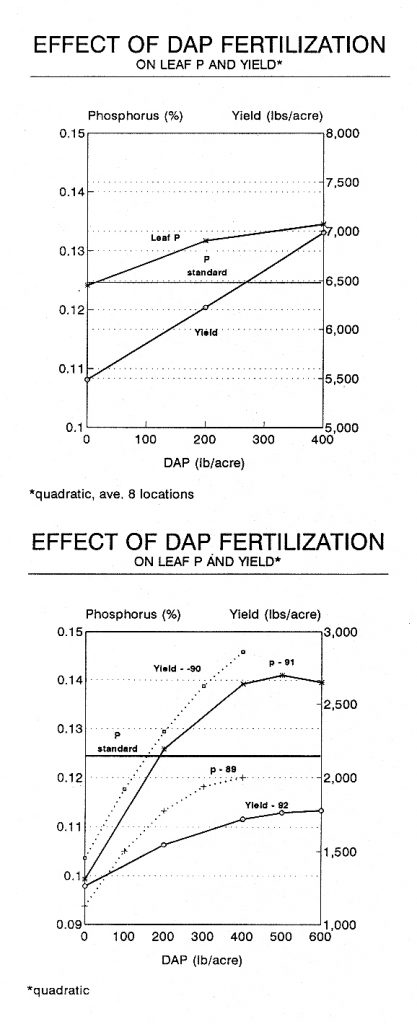225-Fertilizing with Nitrogen and Phosphorus
Fact Sheet No. 225, UMaine Extension No. 2094
Prepared by David E. Yarborough, Extension Blueberry Specialist, and John M. Smagula, Emeritus Professor of Horticulture, The University of Maine, Orono, ME 04469. Revised January 2013.
Introduction
Before preemergence herbicides were available blueberry fields were fertilized with only small amounts of nitrogen fertilizer. Growers didn’t want to help weeds grow since weeds also respond to fertilizer. Weeds compete for light, moisture, and nutrients and will lower blueberry yields. However, when growers used herbicides to control weeds, extra fertilizer did not increase yields. In this case, there were enough nutrients in the soil for blueberry production. Recent research indicates higher levels of fertilizer will improve yields if other limiting factors such as having adequate pollination, protection from disease and insect damage and adequate moisture from irrigation are provided see Wild Blueberry Fact Sheet PDF on the Improving Your Wild Blueberry Yields page.
Based on our surveys, most Maine blueberry fields have adequate levels of leaf nitrogen and phosphorus but the levels needed have been increased compared to the leaf nutrient standards set by University of Maine researcher Trevett in 1972. The new standards are found on the Wild Blueberry Fact Sheet No. 223, Interpreting your leaf analysis results.
Soil samples show that soil nutrient levels aren’t always the same as leaf nutrient levels. For example, in some fields where soil phosphorus was low, leaf phosphorus was not low. This is why we don’t make fertilizer recommendations based on soil samples. To find out leaf nutrient levels, you need to sample your non-bearing fields at the tip-dieback stage of growth. Refer to the Wild Blueberry Fact Sheet No. 222, Leaf and Soil Sampling Procedures for detailed methods on leaf and soil sampling.
Results of Fertilizer Experiments
Researchers have experimented with Diammonium phosphate (DAP) and phosphorus (P) fertilizers since 1987 to determine the relationship between fertilizers, leaf nutrients, and blueberry yield. The top graph shows results from one study on eight fields over two years. The bottom graph gives data for one field over four years.
The top graph shows that leaf phosphorus (P) will increase above the standard of 0.125 percent leaf P with DAP fertilization but will begin to level off at 200 lb/a DAP. These lines represent an average response. In other words, some fields had higher or lower leaf P and yields. Studies with P alone showed the same trend, but yields were lower. In this case, Nitrogen (N) was necessary to get a higher yield. New levels developed by Santiago in 2011 indicate that with more intensive practices that higher yields may be obtained than in the past so the recommendations of leaf levels and fertilizer application have been adjusted to reflect the greater demands on the plant.

The graph to the right also illustrates that leaf P and yield will increase with DAP. It also shows that an increase in leaf P does not guarantee an increase in yield: the leaf P was higher in 1991 than 1989, but the yield was lower in 1992 versus 1990. This tells us that factors other than fertilizer have an effect on yield. Having a sufficient number of bees for pollination, adequate moisture and winter injury or frost will affect your yield.
- Download and print the Effect of DAP Fertilization on Leaf P and Yield* Chart (PDF).
Fertilizer Rates
- Be sure to have good weed management if you use fertilizer. Refer to the Wild Blueberry Fact Sheet No. 236, Weed Management in Lowbush Blueberry Fields for more information.
- Use leaf Nitrogen and Phosphorus levels as a guide:
- Low leaf N only:
If leaf N level is below 1.76%, apply N (urea) up to 55 lb/a. If leaf N level is above 1.76%, lesser amounts or no N is needed. - Low leaf N and P:
If leaf P is below 0.111% and leaf N is at or below 1.76%, apply DAP up to 440 lb/a.If leaf P is below 0.111% and leaf N is well above the 1.76% standard, apply monoammonium phosphate (MAP), which provides half the amount of N compared to DAP. Use MAP if plants have extra growth or have winter injury.
- Low leaf N only:
- You can use fertilizer with N, P and potassium (K), but note that K will not increase yield. The form of N provided should be ammonium nitrogen not nitrate nitrogen.
- Every field is different. Keep records of leaf P and N values, fertilizer rates and yields to help you track when production is leveling off or declining. Leave an untreated strip in your field to compare to fertilized areas.
Information in this publication is provided purely for educational purposes. No responsibility is assumed for any problems associated with the use of products or services mentioned. No endorsement of products or companies is intended, nor is criticism of unnamed products or companies implied.
© 1993, 2013
Call 800.287.0274 (in Maine), or 207.581.3188, for information on publications and program offerings from University of Maine Cooperative Extension, or visit extension.umaine.edu.
The University of Maine is an EEO/AA employer, and does not discriminate on the grounds of race, color, religion, sex, sexual orientation, transgender status, gender expression, national origin, citizenship status, age, disability, genetic information or veteran’s status in employment, education, and all other programs and activities. The following person has been designated to handle inquiries regarding non-discrimination policies: Director of Equal Opportunity, 101 Boudreau Hall, University of Maine, Orono, ME 04469-5754, 207.581.1226, TTY 711 (Maine Relay System).
